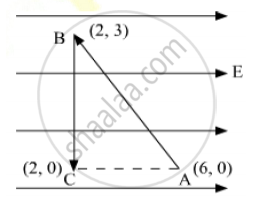Advertisements
Advertisements
प्रश्न
A 100 pF capacitor is charged to a potential difference of 24 V. It is connected to an uncharged capacitor of capacitance 20 pF. What will be the new potential difference across the 100 pF capacitor?
उत्तर
Given :
`C_1 = 100 "pF"`
V = 24 V
Charge on the capacitor `q = C_1V = 24 xx 100 "pC"`
Capacitance of the uncharged capacitor, `C_2 = 20 "pF"`
When the charged capacitor is connected with the uncharged capacitor, the net charge on the system of the capacitors becomes
`q_1 + q_2 = 24 xx 100 "qC"` ....(i)
The potential difference across the plates of the capacitors will be the same.
Thus,
`q_1/C_1 = q_2/C_2`
⇒ `q_1/100 = q_2/20`
⇒ `q_1 = 5q_2` ....................(ii)
From eqs. (i) and (ii), we get
`q_1+q_1/5 = 24 xx 100 "pc"`
⇒ `6q_1 = 5 xx 24 xx 100 "pC"`
⇒ `q_1 = (5xx24xx100)/(6) "pC"`
Now ,
`V_1 = q_1/C_1`
⇒ `(5xx24xx100 "pC")/(6xx100 "pF")` = 20 V
APPEARS IN
संबंधित प्रश्न
Define 1 volt PD.
Distinguish between Conductors and Insulators.
Draw a labelled diagram of Van de Graaff generator. State its working principle to show how by introducing a small charged sphere into a larger sphere, a large amount of charge can be transferred to the outer sphere. State the use of this machine and also point out its limitations.
Explain the principle of a device that can build up high voltages of the order of a few million volts.
A test charge ‘q’ is moved without acceleration from A to C along the path from A to B and then from B to C in electric field E as shown in the figure. (i) Calculate the potential difference between A and C. (ii) At which point (of the two) is the electric potential more and why?

A charge of `+2.0 xx 10^-8 C` is placed on the positive plate and a charge of `-1.0 xx 10^-8 C` on the negative plate of a parallel-plate capacitor of capacitance `1.2 xx 10^-3 "uF"` . Calculate the potential difference developed between the plates.
A charge of 20 µC is placed on the positive plate of an isolated parallel-plate capacitor of capacitance 10 µF. Calculate the potential difference developed between the plates.
A charge of 1 µC is given to one plate of a parallel-plate capacitor of capacitance 0⋅1 µF and a charge of 2 µC is given to the other plate. Find the potential difference developed between the plates.
A capacitor having a capacitance of 100 µF is charged to a potential difference of 50 V. (a) What is the magnitude of the charge on each plate? (b) The charging battery is disconnected and a dielectric of dielectric constant 2⋅5 is inserted. Calculate the new potential difference between the plates. (c) What charge would have produced this potential difference in absence of the dielectric slab. (d) Find the charge induced at a surface of the dielectric slab.
In circuits, a difference in potential from one point to another is often called ______.
The unit of potential difference as used in electrical circuits is ________.
Assertion: Electric potential and electric potential energy are different quantities.
Reason: For a system of positive test charge and point charge electric potential energy = electric potential.
On moving a charge of Q coulomb by X cm, W J of work is done, then the potential difference between the points is ______.
- It depends only on the initial and final position.
- It is the work done per unit positive charge in moving from one point to other.
- It is more for a positive charge of two units as compared to a positive charge of one unit.
A and B are two points in an electric field. If the work done in carrying 4.0C of electric charge from A to B is 16.0 J, the potential difference between A and B is:
An α-particle and a proton are accelerate at same potential difference from rest. What will be the ratio of their final velocity?
A bullet of mass of 2 g is having a charge of 2 µc. Through what potential difference must it be accelerated, starting from rest, to acquire a speed of 10 m/s.
Work done in moving a unit positive charge through a distance of x meter on an equipotential surface is:-
